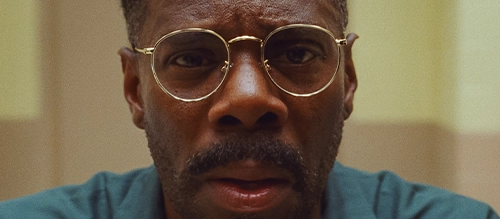
Sing Sing (2024)
Director: Greg Kwedar
Screenwriters: Clint Bentley, Greg Kwedar
Starring: Colman Domingo, Clarence Maclin, Sean San Jose, Paul Raci, David Giraudy, Patrick Griffin, Mosi Eagle, James Williams, Sean Dino Johnson
We’ve seen a lot of art about art recently. Some of it has been used to express contemporary concerns on the future of all art in the face of artificial intelligence, war, and/or hyper-corporatisation, while some of it has been used to offer greater insight into the workings of already existing artists. We’ve seen films on film directors, film directors making films about older films, auteurs being self-reflective, and a new rise in metacontextual texts. What all of these branches have in common is that they celebrate the art itself, fixing the lens on creation, on the deeper meanings behind it, and on the socio-political impact of it. These films bring context into view, celebrating the motivations and impacts of art, encouraging thought, further speculation, and engagement. At their best, they encourage retrospective action, introspection, and even inspiration. Almost all of them encourage empathy, perhaps even absolution. Sing Sing does all of these things.
Based on a true story first outlined by Esquire, Sing Sing tells of the prisoners who create and perform theatre as part of a rehabilitation program at New York’s Sing Sing Prison. Starring Colman Domingo as real-life prisoner and inspiration for the story, Divine G, a creative prisoner whose artistic flair and writing capabilities are respected by his fellow incarcerated citizens, Sing Sing seeks to humanise the real-life criminals behind the true story, celebrating humanity’s capabilities for change. It is a strong portrait of the creative process from the core of an idea through to actualisation, as seen through the eyes of prisoners.
What makes Sing Sing remarkable is its use of real-life criminals. Early in the film, director Greg Kwedar (Transpecos) and cinematographer Patrick Scola (Pig) centre their rich and textured 16mm film stock frame upon the faces of the real-life prisoners that make up their supporting cast, asking each to present themselves as particular characters in the play the film is documenting the creation of. Men with chequered pasts are illuminated with joy, or at least momentary rest from their situations, as they twirl on the spot, enact a gladiatorial battle, or read Shakespeare. We see a man with a tribal tattoo running down the centre of his face (from forehead to chin) set aglow by the camera, immediately humanising a figure who would traditionally be considered scary, thus inviting us to release the shackles of our own prejudices. It’s a remarkable moment, and one that is further emphasised by a similar sequence later in the film that includes one camera shy prisoner accidentally staring into the lens of the camera when partaking in a sharing circle. It’s so tangibly real, and its impact all the more profound for it.
The narrative of Sing Sing is constructed in a similar manner to that of a sports movie, and as such features the emotional highs and predictable moments that movies of that particular genre have long defined. It’s a solid base to build an ensemble around, particularly when most of your ensemble is made up of the real-life prisoners you’re seeking to re-evaluate. It ensures that every character gets their moment, and that each is made memorable in their own right. The traditional story beats are all in place – forming the squad, bringing it together, dealing with conflict, overcoming tragedy, achieving the dream – but Sing Sing presents all of these moments within the core of an identifiable reality; one which is remarkably well-constructed given that most of us will never experience it.

There isn’t much time for backstories or any contemplation as to the lives of those effected by the crimes the prisoners committed, but that isn’t the point. Sing Sing is about the reformative power of art. It doesn’t matter what the prisoners did, only that they are willing to change, and that we witness them grow per their willingness. Witnessing the vulnerability behind confrontations, behind violent action, behind words said and words unsaid, is where the power of the piece lies. These are human beings willing to grow, to change, to evolve.
The dialogue is where the script truly excels. Characters realistically confront their realities, or each other, and only open themselves up as time passes, as trust builds. The communication these men have with each other is realistic – not just to prisoners incarcerated in the same place, but to men in general – and watching them grow from distant and defensive to open and vulnerable is likely to speak to any man anywhere. Sing Sing lets us know that it is more powerful to love than it is to hate.
All of this wouldn’t hit quite as hard as it does were it not for the power of the acting, and Sing Sing holds a lot of power. Colman Domingo is remarkable in his vulnerability as the lead, embodying a man holding a weight we only get brief glimpses at. Everything he says is believable, but his face is his most powerful tool. Paul Raci, Oscar-nominated for his performance in Sound of Metal (2019), is grittily voiced and stony faced, but an enriching presence among fellow actors and prisoners alike. It is, however, the real-life reformed prisoner Clarence Maclin who is the most unmissable here. Maclin plays a version of himself, even being defined in-film as his real-life nickname Divine Eye, and his performance as the rough and tough presence turned quietly artistic main support is as rich and moving and beautifully defined as any you’re likely to see in 2024. It may be one of the performances of the decade. For the vulnerability he holds behind a realistically aggressive outer persona, and his range from angry to funny to loving, an Oscar nomination must await.
There will always be voices that seek to dismiss films like Sing Sing for the sake of their political views, but those naysayers don’t matter. This is powerful, enriching, empathy-led cinema. It brings together the incarcerated, the reformed, and the professional filmmaker, and it creates one of the year’s most emotive experiences; a genuinely important cinema release on the power of art and creation that is worth experiencing alone in the dark.
Score: 20/24

